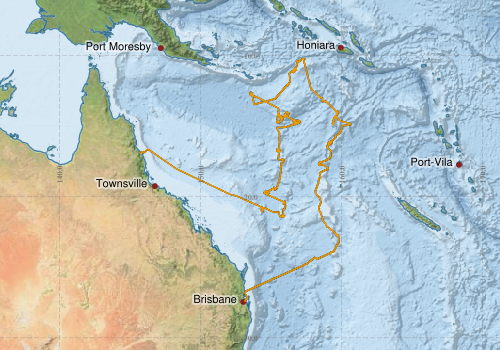Keyword
Countries | Solomon Islands
5 record(s)
Type of resources
Topics
Keywords
Contact for the resource
Provided by
Formats
Update frequencies
Status
draft
-

This record describes sub bottom profiler data collected on RV Investigator voyage IN2019_V04, 'Hotspot dynamics in the Coral Sea: connections between the Australian plate and deep Earth' which departed Cairns on the 7th August 2019 and returned to Brisbane on the 3rd September 2019. The Kongsberg SBP120 (sub bottom profiler) was used to acquire data, containing the specular reflections at different sediment interfaces below the seafloor, in the Coral Sea within the EEZ of Australia, Papua New Guinea, Solomon Islands and New Caledonia The SBP120 provides a 3° by 3° angular resolution. The echosounder's frequency sweep range is from 2.5 to 7 kHz. The SBP120 was logged continuously whilst underway during the voyage. Data are stored in *.raw (859 files 19.3 GB) raw and *.seg (868 files 19.7 GB) segy formats at CSIRO. There are additional *.seg files due to line splitting that was required. The segy format data had a real time processing stream applied, which applies gain, a gain correction, matched filter with replica shaping and time variable gain. Instantaneous amplitude was not applied in the processing stream. Additional information regarding this dataset is contained in the GSM data acquisition and processing report. Additional data products may be available on request
-

This record describes gravity data collected on RV Investigator voyage IN2019_V04, 'Hotspot dynamics in the Coral Sea: connections between the Australian plate and deep Earth' which departed Cairns on the 7th August 2019 and returned to Brisbane on the 3rd September 2019. The gravity meter instrument is a MicroG Lacoste Air-Sea II and was run continuously during the voyage in the Coral Sea, within the EEZ of Australia, Papua New Guinea, Solomon Islands and New Caledonia. Data are stored in .ENV and .DAT data files at CSIRO. There are 57 files totalling 463 MB of raw data in this dataset. Wharf ties were undertaken at the start and end of the voyage using a Scintrex Autograv CG-5. Reference station number 2008909952 was used in Cairns (located at Cairns airport) and station number 2016909147 was used in Brisbane (located at Northshore Riverside Park). Wharf tie data can be found in "Cairns_wharf_gravity_tie_in2019_v04.TXT" and "Brisbane_wharf_gravity_tie_post_in2019_v04.TXT", which are stored with the raw data folder. No processing has been conducted on this data. Additional information regarding this dataset is contained in the GSM data acquisition and processing report.
-

This record describes magnetometer data collected on RV Investigator voyage IN2019_V04, 'Hotspot dynamics in the Coral Sea: connections between the Australian plate and deep Earth' which departed Cairns on the 7th August 2019 and returned to Brisbane on the 3rd September 2019. The instrument is a Marine Magnetics SeaSPY2 magnetometer and was deployed while transiting during the voyage in the Coral Sea, within the EEZ of Australia, Papua New Guinea, Solomon Islands and New Caledonia. Data are stored in .CSV and .MMS data files at CSIRO. 872 MB of raw data was acquired in this dataset. No processing has been conducted on this data. The SeaSPY2 magnetometer uses an omnidirectional Overhauser sensor that requires no realignment or recalibration and has no heading error. The instrument has an absolute accuracy of 0.1 nT, sensor sensitivity of 0.01 nT and resolution of 0.001 nT.” The magnetometer was towed 300m astern of the ship and a layback value of 361m was applied to the magnetometer data. This was the total distance behind the ship's positioning reference point. Additional information regarding this dataset is contained in the GSM data acquisition and processing report.
-

This record describes multibeam echosounder data collected on RV Investigator voyage IN2019_V04, 'Hotspot dynamics in the Coral Sea: connections between the Australian plate and deep Earth', which departed Cairns on the 7th August 2019 and returned to Brisbane on the 3rd September 2019. The Kongsberg EM122 multibeam echosounder was used to acquire seafloor bathymetry, backscatter information and watercolumn backscatter in the Coral Sea, within the EEZ of Australia, Papua New Guinea, Solomon Islands and New Caledonia. The EM122 provides a 1 degree by 1 degree angular resolution. The echosounder's nominal frequency is 12 kHz. Data are stored in *.all raw format for bathymetry and backscatter and *.wcd format for watercolumn backscatter at CSIRO. There are 977 files totalling 49.2 GB of raw data in this dataset. Sound velocity profiles were applied to this data during data acquisition. Bathymetry data contained in *.all format are corrected for motion and position. Tide corrections were not applied to the processed data. Processed data had outliers removed. Processed line data are available in *.gsf and ascii format, and processed bathymetry and backscatter grids in geotiff format. Additional information regarding this dataset, including information on processing streams, is contained in the GSM data acquisition and processing report. Additional data products may be available on request.
-

This record describes scientific split-beam echosounder data collected on the RV Investigator voyage IN2019_V04, 'Hotspot dynamics in the Coral Sea: connections between the Australian plate and deep Earth', which departed Cairns on the 7th August 2019 and returned to Brisbane on the 3rd September 2019. The Simrad EK60 split beam echosounders 18, 38, 70 120, 200 and 333 kHz were used to acquire acoustic backscatter data to a range of 1500 m in the Coral Sea, within the EEZ of Australia, Papua New Guinea, Solomon Islands and New Caledonia. All frequencies were logged continuously for the extent of the voyage. Data are stored in *.raw, *.bot and *.idx format at CSIRO. There are 766 files totalling 73.9 GB of raw data in this dataset. No processing has been conducted on this data. Additional information regarding this dataset is contained in the GSM data acquisition and processing report. Additional data products may be available on request.
